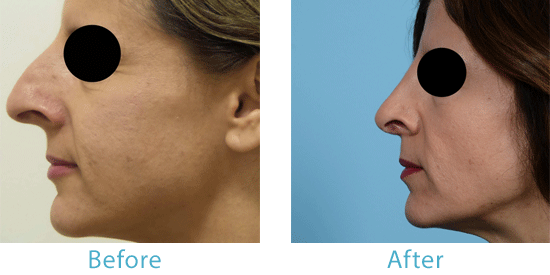If you’ve ever considered facial plastic surgery, especially rhinoplasty, you’ll know that the idea of changing your features can be exciting and overwhelming at the same time. In order to approach the surgery with confidence rather than anxiety, you should do some extensive and thoughtful research beforehand. I find that rhinoplasty patients at my plastic surgery practice in Chicago who have a thorough understanding of the procedure and their options are often more satisfied with their results.
To get started, here are a few of the factors I suggest you consider first. Hopefully, you’ll find them to be a helpful guide for your research and planning.
A Surgeon’s Qualifications & Experience
Choosing an excellent surgeon to perform your rhinoplasty is one of the most important decisions you can make. While exploring your options, look for the surgeon’s qualifications and experience as a top priority.
Certified by Reputable Boards
The surgeon should be certified by The American Board of Plastic Surgery, to begin with. Additional certifications, such as from the American Board of Otolaryngology, are also signs of quality. Surgeons certified by these boards are held to the highest standards of education, experience, and skill. They have received training from world-class surgeons and have demonstrated their ability to perform safe, efficient procedures with natural-looking results.
Specialist in Rhinoplasty
Additionally, the surgeon you choose should specialize in rhinoplasty. While many plastic surgeons have been trained to perform rhinoplasty and understand the general techniques, they may specialize in body contouring or another form of plastic surgery. Think of it this way: You wouldn’t hire a mechanic who specializes in European vehicles to work on your Honda, would you?
If you’re not sure what areas a surgeon specializes in, you may be able to look in a few places. First, examine the doctor’s CV and see what areas of surgery they were trained in. Then, look through the surgeon’s website and determine which procedures are highlighted or emphasized.
Positive Reviews
Take a look at real patient reviews on the website and third-party review sites such as RealSelf.com. If previous patients have given that surgeon positive ratings for rhinoplasty, then you’re on the right track.
Good Rapport
And lastly, once you get to the consultation stage, simply ask the surgeon how many rhinoplasty procedures he or she has performed, as well as how many in the past year.
Before & After Photos
After you’ve narrowed down your choices to a few surgeons, begin looking through their photo galleries. Look closely at the rhinoplasty before-and-after photos, considering patients with similar facial features to you. Then ask yourself if you like their results. Would you want something different? Jot down some notes and bookmark cases you like best.
These before-and-after images can give you a much more realistic impression of what is possible for your results than 3-D imaging and discussion with the doctor alone. Plus, they can help you get an idea of the surgeon’s aesthetic.
Once you meet with an experienced surgeon in person, he or she should be able to give you several examples of noses with similar features to yours and a range of results depending on your individual wishes. Below are some of the before-and-after images from my gallery. I take images of as many patients as possible, giving future patients a greater range of examples to review.
You may also look for more examples outside of a doctor’s website. Find some examples of noses you’d like to see on yourself, available in before-and-after galleries, celebrity faces, Pinterest, and other resources. Bring those “goal photos” in with you to your appointment.
3D Imaging
Many surgeons emphasize 3D imaging to help a patient visualize their outcome. Although I do sometimes use imaging, there are significant drawbacks that patients should recognize. I have seen many patients for revision rhinoplasty who bring in the image their original surgeon provided but was not able to reproduce. There is an implication that can lead to false expectations and is not necessarily reflective of the surgeon’s skill.
My major reservation is that imaging systems carry the inherent assumption that the nose is a piece of clay that is moldable into any shape. However, the nose is composed of 5 major cartilages and a bony segment, covered by a skin covering of variable thickness. The skin can at best be minimally modified by thinning slightly, and the framework must have sufficient strength, which places constraints on what can be done.
My philosophy is to modify the cartilage and bony framework to only correct what is displeasing while retaining structural strength, which results in a natural result that cannot be fully predicted by an imaging system. While imaging can be useful, I find that examples of pre- and post-op photos of patients with similar noses to yours give a more realistic vision of what is reliably achievable.
Realistic Expectations of Results
While it’s a great idea to bring pictures of your favorite noses to your consultation as inspiration, consider that no surgeon will be able to make you look like someone else. In fact, it is a priority of mine to customize each patient’s results to meet his or her aesthetic goals, taking into consideration the following factors:
- Underlying framework of the nose
- Skin thickness
- The other facial features
Because of these factors, no 2 patient results will look the same–and that’s a good thing. You should have a natural-looking result that fits your unique face.
Recovery Process
It’s wise to consider that after rhinoplasty surgery, you should be ready to take time off work and not schedule any major events for a few weeks. (See this blog post on preparing for recovery.) Most surgeons say their patients have bruising for 2 weeks or more, while my patients usually have minimal bruising that can easily be covered by makeup in 1 week. Some even have no bruising at all! However, swelling is present in all cases and can take a while to fade. Most of my patients return to work or resume normal activities within 1 week of surgery, and the final nose shape and profile become evident around this time.
Swelling will last longer, typically resolving for the most part in 4 to 6 weeks, with some minimal swelling gradually resolving over a year. Each patient heals differently, so the timing will vary. I’ve operated on several professional models who have all resumed modeling within 2 weeks! It all depends on your body. Just keep in mind that you will need to make special arrangements in the weeks following your surgery.
For other information on how to prepare for rhinoplasty, view this blog post. If you’re ready to proceed with a nose job in the Chicago area, I invite you to request a consultation so we can meet in person and discuss your candidacy further. I look forward to helping you!




Leave a Reply